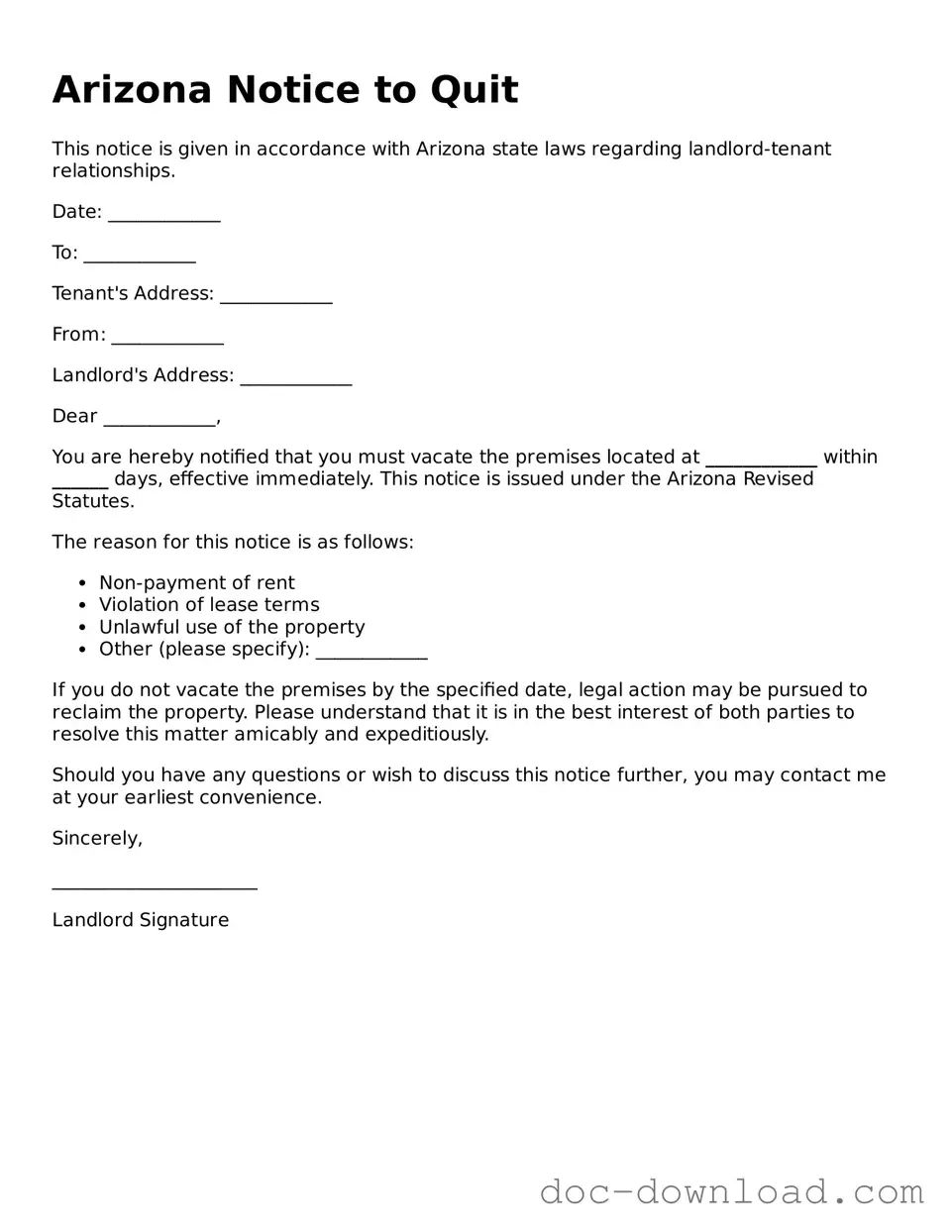The Arizona Notice to Quit form is similar to the Eviction Notice. Both documents serve to inform a tenant that they must vacate the rental property. An Eviction Notice is often used when a landlord seeks to terminate a lease due to non-payment of rent or lease violations. The Notice to Quit, however, can be used for various reasons, including the end of a lease term or failure to comply with rental agreements. Both documents initiate the process of removing a tenant from a property, but they may differ in the specifics of the reasons for termination.
Another document that resembles the Arizona Notice to Quit is the Lease Termination Notice. This notice is used by landlords to inform tenants that their lease will not be renewed at the end of the lease term. Similar to the Notice to Quit, it provides a clear timeline for when the tenant must vacate the premises. However, the Lease Termination Notice is typically issued at the end of a lease period, while the Notice to Quit can be issued at any time during the lease for various reasons.
The Three-Day Notice to Pay Rent or Quit is also comparable to the Arizona Notice to Quit. This document specifically targets tenants who have failed to pay their rent. It gives the tenant three days to either pay the overdue rent or vacate the property. While both notices serve the purpose of prompting a tenant to leave, the Three-Day Notice is focused solely on rent issues, whereas the Notice to Quit can address a broader range of lease violations.
The 30-Day Notice to Vacate is another similar document. This notice is used by landlords to inform tenants that they must leave the property in 30 days. This type of notice is often used when a landlord wants to end a month-to-month rental agreement. Like the Notice to Quit, it provides a clear timeframe for the tenant to vacate, but it is less urgent and typically does not address specific lease violations.
The Notice of Default can also be likened to the Arizona Notice to Quit. This document is often used in the context of mortgage agreements but can apply to rental situations as well. It notifies a tenant that they are in default of their lease terms and must take corrective action or face eviction. Both notices aim to address compliance issues, but the Notice of Default is more focused on the consequences of failing to meet financial obligations.
The Demand for Possession is another document that shares similarities with the Arizona Notice to Quit. This document is typically issued after a tenant has failed to comply with lease terms. It demands that the tenant vacate the property, often after an eviction lawsuit has been filed. While both documents seek to remove a tenant, the Demand for Possession usually follows a legal proceeding, whereas the Notice to Quit can be issued independently.
As landlords navigate various documents associated with rental agreements, such as the Georgia Durable Power of Attorney form, understanding the best practices for communication is essential. This form, pivotal in allowing one individual to act on behalf of another, especially regarding financial and health matters, provides clarity and peace of mind throughout the eviction process. This legal empowerment can be particularly beneficial for those managing multiple properties, ensuring that decisions are made smoothly and effectively. For more information, you can refer to Georgia PDF Forms.
The Rent Demand Notice is also comparable. This notice is specifically aimed at tenants who have not paid their rent. It serves as a formal request for payment and often precedes eviction proceedings. Like the Notice to Quit, it is a step in the process of removing a tenant, but it focuses solely on rent payments rather than other lease violations.
Lastly, the Notice of Lease Violation is similar to the Arizona Notice to Quit. This document is used to inform tenants that they have violated specific terms of their lease agreement. It outlines the violations and provides a timeframe for the tenant to correct them. While both notices can lead to eviction, the Notice of Lease Violation is more about addressing specific issues, whereas the Notice to Quit can be more general in its approach.
